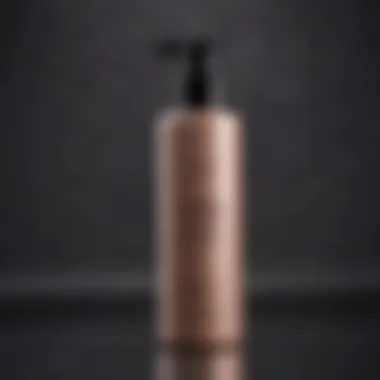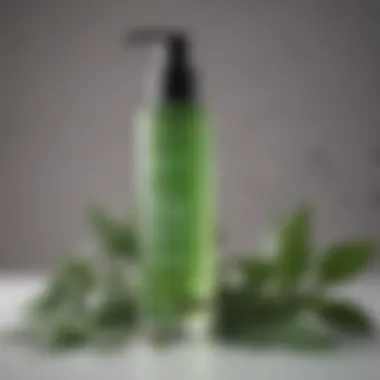Expert Guide to Selecting the Best Leave-In Conditioner for Oily Hair


Hair Care Techniques & Strategies
When it comes to managing greasy hair, selecting the right leave-in conditioner is crucial. Grease and oiliness can be a persistent issue for many individuals, impacting both their confidence and overall appearance. Understanding the root causes of greasy hair is the first step towards effectively addressing this concern. Factors such as excess sebum production, environmental pollutants, and improper hair care routines can contribute to greasy hair. By delving into these factors, individuals can gain valuable insights into why their hair may be prone to greasiness.
The Science Behind Greasy Hair
The human scalp possesses sebaceous glands that produce sebum, a natural oil that helps moisturize and protect the hair and scalp. However, when these glands produce an excess amount of sebum, it can lead to greasy hair. External factors such as humidity, pollution, and certain hair products can exacerbate this condition, making it challenging to maintain a fresh and clean look. Understanding the science behind greasy hair is essential for selecting the right leave-in conditioner that can effectively regulate oil production and provide hydration without weighing down the hair.
Choosing the Right Leave-In Conditioner
Finding the best leave-in conditioner for greasy hair requires careful consideration of key factors. Opting for lightweight formulas that are specifically designed for oily hair can help prevent product buildup and ensure that the hair remains fresh and voluminous. Ingredients such as tea tree oil, witch hazel, and salicylic acid are known for their clarifying and balancing properties, making them ideal choices for individuals struggling with greasiness. Additionally, seeking products that offer UV protection can shield the hair from environmental damage while maintaining its natural shine.
Application Techniques and Best Practices
Once the ideal leave-in conditioner is selected, mastering the application techniques is essential for achieving optimal results. Applying a small amount of product to the mid-lengths and ends of the hair, while avoiding the scalp, can prevent excess oiliness and heaviness. Incorporating the leave-in conditioner into a well-rounded hair care routine that includes gentle cleansing and regular trims can further enhance its effectiveness in controlling greasy hair. By following these strategies and investing in the right products, individuals can embrace their natural beauty and confidently showcase their radiant, healthy hair.
Understanding Greasy Hair
Everyday, millions of individuals face the relentless battle against greasy hair. Understanding the intricacies of greasiness is pivotal in our quest for healthy, luscious locks. The buildup of excess oils on our scalp can be attributed to various factors such as genetics, hormonal imbalances, and overactive sebaceous glands. By delving into the root causes of greasy hair, we equip ourselves with the knowledge necessary to combat this common hair dilemma effectively.
Causes of Greasy Hair
Genetics:
Genetics plays a significant role in determining the natural state of our hair. Some individuals are genetically predisposed to produce higher amounts of sebum, the oily substance that lubricates our scalp and hair. While this genetic tendency towards oiliness can be challenging, understanding this aspect is crucial in selecting the right hair care products, including leave-in conditioners. Finding formulations that cater to oily hair types can help alleviate the greasiness associated with genetic factors.
Hormonal Factors:
Hormonal fluctuations can also contribute to greasy hair. During various stages of life, such as puberty, pregnancy, or menopause, hormonal changes can stimulate the sebaceous glands to produce more oil. This excess sebum can lead to a greasy appearance and texture of the hair. Considering the impact of hormonal factors on greasiness is essential when choosing the appropriate hair care products to maintain a balanced scalp.
Overactive Sebaceous Glands:
The overactivity of sebaceous glands is another leading cause of greasy hair. These glands are responsible for oil production, and when they produce an excess amount of sebum, it can leave hair looking and feeling oily. Understanding the role of overactive sebaceous glands in greasiness underscores the importance of using targeted hair care products that can regulate oil production without stripping the hair of essential moisture.


Impact on Hair Health
Weighed-Down Hair:
The accumulation of excessive oils can weigh down the strands, making the hair appear flat and lacking volume. Greasy hair tends to clump together, diminishing its natural bounce and vitality. This weighed-down effect not only affects the aesthetics of the hair but can also impact overall hair health by potentially weakening the strands and leading to breakage.
Promotes Scalp Issues:
Greasy hair often goes hand in hand with scalp issues such as dandruff or itchiness. The excess sebum on the scalp can create an environment conducive to microbial growth, leading to scalp conditions that may cause discomfort and compromise hair health. Addressing greasiness is essential in preventing and alleviating these associated scalp issues for a healthier overall hair environment.
Affects Styling:
Styling greasy hair can be a challenge, as the excess oils can hinder the efficacy of hair products and tools. From difficulties in holding a hairstyle to the tendency for styles to unravel quickly, greasiness can disrupt the desired look and hold of various hairdos. Considering how greasy hair impacts styling choices can guide individuals in selecting the right products to achieve their desired looks while managing oiliness effectively.
Choosing the Right Leave-In Conditioner
Choosing the right leave-in conditioner for greasy hair is a crucial step in maintaining healthy and manageable hair. Greasy hair poses unique challenges, such as excess oil production, which can weigh down the hair and lead to scalp issues. The proper leave-in conditioner can help address these issues by providing essential nourishment without adding excess weight. In this article, we will delve into the specific elements that make a leave-in conditioner suitable for greasy hair, including lightweight formulas, clarifying ingredients, and hydrating components, to help readers make informed decisions and achieve balanced hair care.
Understanding Ingredients
Lightweight Formulas
Lightweight formulas play a pivotal role in addressing the needs of greasy hair. These formulations are specifically designed to provide hydration and conditioning without adding heaviness to the hair. By opting for a lightweight formula, individuals with greasy hair can enjoy the benefits of a leave-in conditioner without exacerbating oiliness. The key characteristic of lightweight formulas is their ability to nourish the hair and scalp effectively while ensuring a weightless finish. This feature is particularly advantageous for individuals with greasy hair, as it helps maintain a fresh and clean look without overwhelming the hair with product buildup.
Clarifying Ingredients
Clarifying ingredients are essential for combating oiliness and build-up in greasy hair. These ingredients work to cleanse the scalp and hair thoroughly, removing excess oil and product residue that can contribute to greasiness. By incorporating clarifying ingredients into a leave-in conditioner, individuals can effectively purify their hair and scalp, promoting a healthier balance. The key characteristic of clarifying ingredients is their ability to detoxify the hair and scalp, leaving them feeling refreshed and revitalized. While clarifying ingredients offer significant benefits in managing greasy hair, it is essential to note that frequent use may lead to dryness, necessitating a balanced approach to maintain optimal hair health.
Hydrating Components
Hydrating components are vital for ensuring adequate moisture levels in greasy hair. While excessive oil production is a common issue for individuals with greasy hair, it is essential to balance this with proper hydration to avoid dryness and scalp imbalances. Hydrating components in a leave-in conditioner help nourish the hair strands while maintaining the scalp's moisture levels, promoting overall hair health. The unique feature of hydrating components is their ability to hydrate the hair without adding excess weight or contributing to oiliness. By incorporating hydrating components into their hair care routine, individuals can achieve a harmonious balance between moisture and sebum production.
Considerations for Greasy Hair
Ideal Consistency


The ideal consistency of a leave-in conditioner for greasy hair plays a significant role in its effectiveness. A lightweight and non-greasy consistency is desirable for individuals with greasy hair to prevent further oil build-up. The key characteristic of the ideal consistency is its ability to provide hydration and nourishment without leaving a heavy residue on the hair. By choosing a leave-in conditioner with the right consistency, individuals can enjoy the benefits of conditioning without exacerbating greasiness.
Oil-Free Formulas
Oil-free formulas are a popular choice for individuals with greasy hair due to their ability to provide moisture without adding additional oils. These formulations are designed to hydrate the hair and scalp effectively without contributing to excess oil production. The key characteristic of oil-free formulas is their ability to nourish the hair while maintaining a light and clean feel. By opting for oil-free formulas, individuals can address the moisture needs of their hair without weighing it down or causing greasiness.
Mattifying Properties
Mattifying properties in a leave-in conditioner are beneficial for controlling excess shine and oiliness in greasy hair. These properties work to absorb excess oil on the scalp and hair, promoting a matte finish that reduces the appearance of greasiness. The key characteristic of mattifying properties is their ability to offer a shine-free look while maintaining adequate hydration. While mattifying properties can help manage greasy hair effectively, it is important to consider individual preferences and hair types when incorporating them into a hair care routine.
Popular Leave-In Conditioners for Greasy Hair
In the realm of hair care, selecting the right leave-in conditioner for greasy hair can be a game-changer. These products are formulated specifically to address the unique needs of oily hair, offering solutions that help balance oil production without weighing the hair down. When it comes to managing greasy hair, choosing the right leave-in conditioner is crucial for achieving a healthy and fresh look. Popular leave-in conditioners designed for greasy hair play a significant role in helping individuals combat excess oil and maintain vibrant, voluminous hair.
Brand A
- Key Features: Exploring the key features of Brand A reveals a blend of lightweight yet deeply nourishing ingredients curated to hydrate the hair without adding extra grease. These key features contribute to the overall effectiveness of the product, ensuring that it delivers vital nutrients without overwhelming the hair with unnecessary oils. The unique feature of these key characteristics lies in their ability to provide intense hydration to the hair while maintaining a lightweight feel, making it an ideal choice for those with greasy hair seeking moisture balance. Moreover, the advantages of these key features include improved hair health and a reduction in greasiness.
- User Reviews: User reviews of Brand A shed light on the positive experiences shared by consumers who have incorporated this product into their hair care routine. These reviews highlight the product's ability to effectively manage greasiness, improve overall hair texture, and leave a fresh, clean feel after each use. The unique feature of these user reviews lies in their consensus on the product's efficacy in controlling oil production and enhancing hair health. While the advantages of these user reviews include increased volume and reduced scalp issues, potential disadvantages may include higher pricing relative to similar products.
- Pricing: Delving into the pricing aspect of Brand A reveals a reflection of the product's quality and effectiveness. The pricing factor contributes to the overall accessibility and value proposition of the conditioner, aligning with the benefits it delivers to individuals with greasy hair. The unique feature of the pricing structure lies in its balance between quality ingredients and affordability, offering customers a compelling choice for managing oily hair effectively. While the advantages of the pricing echo its value for money and product quality, potential disadvantages might relate to budget constraints for some users.
Brand B
- Key Features: Analyzing the key features of Brand B showcases a selection of clarifying ingredients aimed at deep-cleansing the hair and scalp to combat greasiness. These features play a pivotal role in ensuring that the hair is thoroughly cleansed of excess oils and impurities, promoting a refreshed and revitalized appearance. The unique feature of these key characteristics lies in their ability to provide a deep-cleansing effect without stripping the hair of essential moisture, making it a sought-after option for those with oily hair seeking a thorough cleanse. The advantages of these key features include improved scalp health and reduced greasiness.
- User Reviews: User reviews of Brand B highlight the product's efficacy in clarifying the hair, maintaining freshness, and enhancing styling options for individuals with oily hair. These reviews underscore the positive experiences shared by users who have noticed a significant improvement in their hair texture, scalp condition, and overall manageability. The unique feature of these user reviews lies in their emphasis on the product's ability to transform greasy hair into voluminous, healthy locks. While the advantages of these user reviews encompass enhanced styling capabilities and reduced greasiness, potential disadvantages may revolve around personal preferences for scent or texture.
- Pricing: Investigating the pricing details of Brand B reflects its positioning in the market as a premium yet effective solution for greasy hair concerns. The pricing aspect aligns with the quality and benefits offered by the conditioner, ensuring that users receive value for their investment. The unique feature of the pricing structure lies in its premium positioning, catering to individuals seeking high-quality products for greasy hair management. The advantages of the pricing include product effectiveness and long-lasting results, while potential disadvantages may include higher costs compared to mainstream alternatives.
Brand
- Key Features: Evaluating the key features of Brand C unveils a focus on mattifying properties that help control oil production and promote a naturally matte finish. These key features are designed to address the specific needs of greasy hair, absorbing excess oil while providing essential nourishment to the hair strands. The unique feature of these key characteristics lies in their mattifying effect, which helps individuals maintain a fresh and oil-free look throughout the day. The advantages of these key features include enhanced styling options and reduced greasiness.
- User Reviews: User reviews of Brand C emphasize the product's ability to deliver on its promises of controlling oil, maintaining hair health, and promoting a matte appearance. These reviews showcase the satisfaction expressed by users who have experienced enhanced volume, improved texture, and reduced oiliness after using this conditioner. The unique feature of these user reviews lies in their praise for the product's long-lasting mattifying effect, ensuring that greasy hair stays fresh and manageable for extended periods. While the advantages of these user reviews encompass long-lasting results and improved hair texture, potential disadvantages may relate to individual hair types and preferences.
- Pricing: Assessing the pricing structure of Brand C reflects its commitment to offering an effective solution for greasy hair at a competitive price point. The pricing strategy balances quality and affordability, making the product accessible to a wide range of users seeking to combat greasiness. The unique feature of the pricing lies in its affordability without compromising on the product's efficacy, providing customers with an appealing choice for managing oily hair effectively. The advantages of the pricing include accessibility and product performance, while potential disadvantages may pertain to individual budget considerations or availability in specific markets.
Application Tips and Techniques
In the realm of choosing the best leave-in conditioner for greasy hair, the application tips and techniques segment plays a vital role in ensuring optimal results. Properly understanding how to apply the conditioner can significantly impact its effectiveness. By focusing on specific elements such as the amount to use, application frequency, and distribution techniques, individuals can maximize the benefits and address considerations unique to greasy hair maintenance.
Proper Application
Amount to Use


Exploring the aspect of the amount to use in applying leave-in conditioner for greasy hair unveils a crucial detail contributing to overall efficacy. Determining the appropriate quantity is essential for preventing product build-up and maintaining hair balance. The key characteristic of identifying the right amount to use lies in achieving adequate coverage without weighing down the hair. This balance ensures proper nourishment without overwhelming the scalp, making it a popular choice for individuals striving to manage greasy hair effectively. The unique feature of the correct amount to use is its versatility in catering to varying hair types and textures, providing advantages such as enhanced hydration and minimized greasiness.
Application Frequency
Delving into the significance of application frequency sheds light on a fundamental aspect of hair care routines for those with greasy hair. Establishing a consistent schedule for applying leave-in conditioner helps regulate sebum production while maintaining hair health. The key characteristic of determining the ideal application frequency is sustaining a balance between nourishment and oil control tailored to greasy hair conditions. This approach proves beneficial by promoting manageable, healthy hair with minimized greasiness, making it a favored choice within the context of this article. The unique feature of application frequency lies in its adaptability to individual needs, offering advantages such as improved scalp health and prolonged freshness.
Distribution Techniques
The exploration of distribution techniques in applying leave-in conditioner presents a pivotal contribution to achieving desirable outcomes for greasy hair management. Understanding how to evenly distribute the product ensures thorough coverage and absorption, optimizing its benefits. The key characteristic of effective distribution techniques is the ability to prevent product residue and evenly coat the hair strands for comprehensive nourishment. This quality makes it a popular choice among individuals seeking to combat greasiness and enhance hair health effectively. The unique feature of distribution techniques lies in their versatility across various hair lengths and styles, providing advantages like improved texture and minimized oiliness.
Styling Recommendations
Preventing Greasiness
Discussing the specific aspect of preventing greasiness in styling recommendations unveils a strategic approach to maintaining fresh, voluminous hair. Emphasizing techniques that alleviate excess sebum production and promote scalp health is crucial in combating greasiness. The key characteristic of these strategies lies in their ability to absorb oil and add texture to the hair, thus preventing unwanted greasiness. This feature makes preventive measures a popular choice among individuals seeking long-lasting freshness and shine, aligning with the goals set forth in this article. The unique feature of preventing greasiness is its adaptability to various styling preferences and hair types, offering advantages such as prolonged cleanliness and enhanced manageability.
Enhancing Volume
Exploring the aspect of enhancing volume in styling recommendations reveals a transformative method to elevate hair texture and fullness for individuals with greasy hair. Implementing techniques that boost volume while combating greasiness creates a harmonious balance conducive to fresh, voluminous hair. The key characteristic of volume-enhancing methods is their ability to impart body and lift to the hair, addressing flatness while maintaining cleanliness. This quality makes enhancing volume a favored choice among those seeking to add dimension and vitality to their hairstyles, aligning with the objectives outlined in this article. The unique feature of enhancing volume lies in its compatibility with various hair lengths and styles, offering advantages like increased thickness and improved overall appearance.
Maintaining Freshness
Delving into the aspect of maintaining freshness within styling recommendations emphasizes the importance of sustaining a clean, revitalized look for greasy hair. Adopting practices that prolong freshness and control oil buildup ensures a vibrant, polished appearance throughout the day. The key characteristic of freshness maintenance techniques is their ability to absorb excess oil and maintain hair texture, promoting lasting cleanliness and manageability. This attribute positions freshness maintenance as a popular choice among individuals aiming to extend the longevity of their styles while minimizing greasiness, aligning seamlessly with the objectives of this article. The unique feature of maintaining freshness lies in its adaptability to diverse lifestyles and environmental conditions, offering advantages such as prolonged style retention and renewed vibrancy.
Conclusion
In the realm of selecting the best leave-in conditioner for greasy hair, the conclusion plays a pivotal role in consolidating all discussed elements. Understanding the significance of concluding thoughts is crucial as it encapsulates the essence of the entire process. The reader is guided towards making an informed decision by reviewing the key points covered in this guide. Without a well-rounded conclusion, individuals may struggle to synthesize the plethora of information presented throughout the article. Hence, emphasizing the final thoughts ensures a coherent and logical end to the decision-making process.
Final Thoughts
Choosing the Right Product
Delving into the aspect of selecting the appropriate product is paramount in the landscape of greasy hair management. The right choice greatly influences the overall effectiveness of the hair care regimen, impacting the texture and quality of the hair. Key characteristics like oil-free formulas, lightweight consistency, and mattifying properties are instrumental in combating greasiness. These features make choosing the right product a popular and beneficial option for individuals dealing with oily hair. The unique feature of tailored formulations for greasy hair ensures that the product addresses this specific concern with precision. However, extensive research is advised to mitigate potential drawbacks, allowing users to make an informed decision based on their individual needs.
Personal Experimentation
Personal experimentation serves as a vital component in the journey towards managing greasy hair effectively. By exploring different products and techniques, individuals can gauge what works best for their unique hair type. The trial-and-error process of personal experimentation empowers individuals to tailor their hair care routine to suit their specific requirements. The key characteristic of adaptability and customization distinguishes personal experimentation as a preferred choice among those seeking optimal solutions for greasy hair. The unique feature lies in the flexibility it offers, allowing individuals to tweak their approach as needed. However, the downside may include potential challenges in finding the perfect match, necessitating patience and persistence in the pursuit of ideal hair care.
Maintaining Hair Balance
Maintaining hair balance is a crucial aspect of greasy hair management, ensuring that the scalp remains healthy and properly nourished. The key characteristic of equilibrium between hydration and oil control is essential in promoting hair health and vitality. This balance is a popular choice for individuals aiming to achieve manageable and lustrous hair despite dealing with greasiness. The unique feature of maintaining hair balance lies in its holistic approach towards hair care, considering both moisturizing and oil-regulating factors. However, potential disadvantages may arise if the balance is not maintained accurately, leading to either dryness or excess oiliness. Thus, meticulous attention is required to strike the right equilibrium and preserve hair health effectively.







